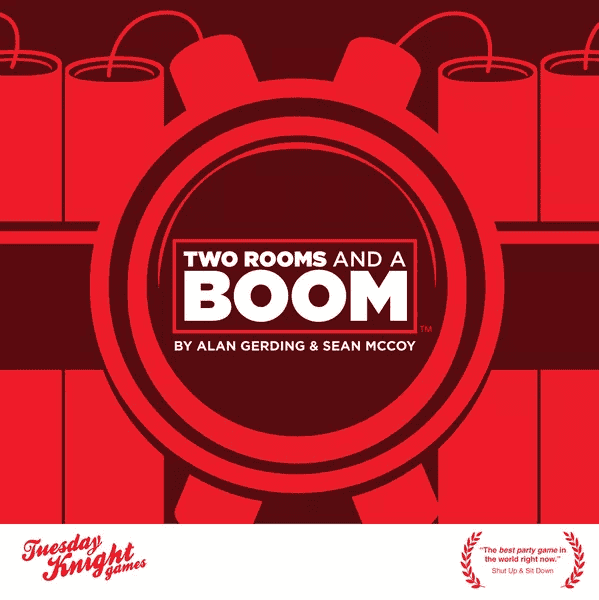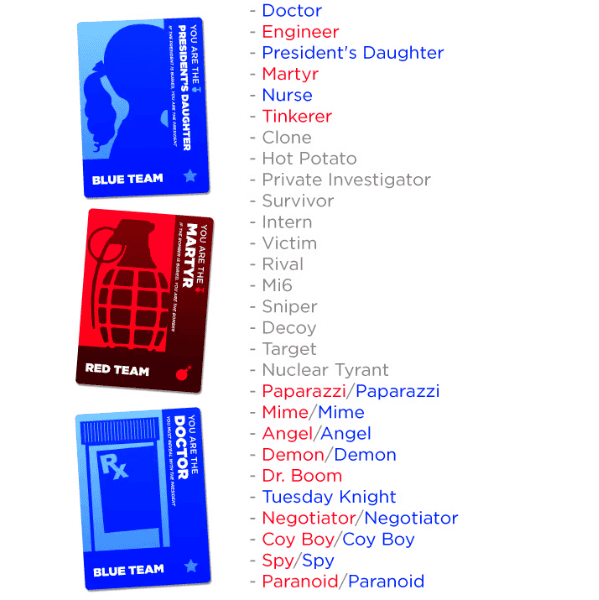
Tuesday Knight Games | 7-20 minutes | 6-30 players | 8 years and up
Two Rooms and a Boom is a highly social game filled with hidden roles, deductive play, and two teams split up into – you guessed it – two rooms. Players are equally distributed into two teams at the beginning of the game. Teammates don’t know who the others on their team are, though, so hostages must negotiate exchanges, establish trust, and race against the clock before the bomb goes kaboom! The game is played over five timed rounds.
What Comes with the Game
Advanced Character cards (over 70 unique plastic character cards)
17 basic Character cards (President, Bomber, 7 Blue Team, 7 Red Team, and the Gambler)
2 Leader cards
Character guide book
Basic rules book
Game box
What is Two Rooms and a Boom?
Two teams of hidden players must strategize, socialize, and negotiate their way to one of two outcomes: all hostages (including the President!) have been released or the whole thing blows up! The game consists of several timed rounds that determine the interaction between players and the outcome of the game.
This no-moderator-needed game allows for layers of intrigue in a quick playing game (just 20 minutes), perfect for a game night filler, larger family gathering, group game night, or icebreaker for just about any type of social gathering. Players are divided into opposing rooms, which adds a strategic element as they aim to win based on their positioning.
It only takes a few minutes to learn how to play. Stop the President from being blown up and discover who the bomber is to stop them in time. That’s pretty much it.
How to Play Two Rooms and a Boom

Set-up for Two Rooms and a Boom Game
Set-up for Two Rooms and a Boom is exceptionally easy. Shuffle the character cards and deal. Ensure everyone knows what each role can and cannot do, explain the easy rules, and divide the group into two rooms. That’s it!
How to Play Two Rooms and a Boom
In Two Rooms and a Boom, gameplay with three rounds occurs. Each round plays out shorter than the previous. At the onset of the game, everyone is split into two groups – one per room. The groups should be as even as possible to create as balanced a play as possible. No moderator is needed, so no one has to sit out the play to lead the game.
Everyone receives a facedown character card. These cards determine who is on the Blue Team or Red Team, who is the Bomber, who is the President, and who is the Gambler. Additional Advanced Character Cards are dealt, adding layers and creative alternatives for players to spice up the gameplay.
A timer is set at the start of each round, and play ensues. Gameplay occurs with players saying what they want to select a team leader for their room. The team leader then chooses hostages and at the end of each round, those hostages are sent to the other room. After the three rounds of hostage exchanges, the game ends. Everyone reveals their character cards to see how successful the mission was. If the Bomber is in the room with the President, the Red Team wins. If the Bomber is separate from the President, the Blue Team wins.
Strategies for Success

During the game, players on the Red Team should attempt to trick the leader of their room into believing they are part of the Blue Team. The Red Team’s Bomber must be in the same room as the opposing team’s President at the end of the game to secure a win, making deception and strategic interactions crucial. But sometimes, Blue Team members have the advantage if they fool their room leaders into thinking they’re part of the Red Team. In fact, it’s a little bit like playing Mafia or One Night Werewolf, without the elimination of players during the game.
Deducing each other’s characters through body language, hints, reveals, and team dynamics is the biggest key to gaining your team’s objective – but beware: players will definitely play up red herrings and false flags if they think you’re being the tricky one. (Trust me, I know!)
The Power of Deception
Deception is the heartbeat of Two Rooms and a Boom, making it a thrilling social deduction and hidden role party game. The Red Team’s Bomber, a master of disguise, must weave a web of lies to infiltrate the Blue Team and set the stage for a dramatic showdown. Meanwhile, the Blue Team is on a high-stakes mission to unmask the Bomber and save the President from a fiery fate.
Imagine the tension as the Bomber, hidden among the Blue Team, pretends to be a loyal ally. They might share just enough truth to gain trust, all while plotting the ultimate betrayal. On the flip side, Blue Team members must be sharp and discerning, piecing together clues and reading between the lines to identify the traitor in their midst.
The game’s design brilliantly supports these deception tactics. Players must be cautious, revealing just enough to build alliances but not so much that they give away their true intentions. This delicate balance of trust and suspicion keeps everyone on their toes, making Two Rooms and a Boom a great game for fans of social deduction and hidden role games. The power of deception is what makes this game not just fun, but an exhilarating mental challenge.
Same Room, Different Perspectives
In Two Rooms and a Boom, the division into two separate playing areas, or rooms, sets the stage for a fascinating interplay of perspectives. Each room becomes a microcosm of alliances, secrets, and strategies, with players working together—or against each other—to achieve their goals.
Take a moment to picture the scene: in one room, a Blue Team member is convinced they’ve found a trustworthy ally, while in the other room, a Red Team player knows that same “ally” is actually a cunning traitor. This disparity in perspectives creates a rich tapestry of tension and uncertainty, making every decision feel weighty and consequential.
The atmosphere in each room can shift dramatically based on the players’ roles and agendas. One room might buzz with confidence and camaraderie, while the other simmers with suspicion and anxiety. These contrasting dynamics make each playthrough of Two Rooms and a Boom unique and unpredictable.
Navigating these different perspectives is key to success. Players must be adept at reading the room, discerning truth from deception, and making strategic moves based on incomplete information. This complexity is what makes Two Rooms and a Boom not just a party game, but a deeply engaging and challenging experience. Whether you’re in the same room or the other room, the game keeps you guessing and strategizing until the very end.
Review
I happen to love this raucous, silly large group game – but I think it’s important to have the right kinds of personalities playing for the best time possible. The best games you’ll have will include players who love a bit of improv or acting – or at least aren’t shy about telling fibs! – and love the movement and negotiation of the bluffing and trickery involved.
Gameplay is quick and energetic, usually pretty loud, and can get a bit wild. The higher the player count, the more energetic and ridiculous it gets, too, with smaller groups often struggling to get as bonkers as groups of at least ten to twelve playing. I’ve never played with 30 players, but I’ve done it with 12 to 20 most often, and this seems just about right for helping out folks who may not be quite as bold as the loudmouths of the group.
I think the quick pace of the game makes Two Rooms and a Boom ideal for icebreakers at the beginning of the night (with established or new groups gathered) and for that mid-evening filler game for an energy boost. It’s also a great option for larger parties where multiple games are going on, assuming you have enough space to divide into two groups and still provide a “less rowdy” area for more think-y players to gather.
I’ve played this game with folks in age ranges from 12 to 70, and everyone seems to enjoy it, no matter how timid they may be and no matter their age. Grandma may not have the energy to do some of the running around team leaders sometimes want, but the young’uns can accommodate as needed.
It should be noted that groups over about 15 will increase the play time significantly, as the more cooks in the kitchen, the more decisions and negotiations occur. So, if you want to keep the game to about 20 minutes, you’ll want to aim for no more than 15 players.
Summary
Two Rooms and a Boom offers a combination of bluffing and cooperative play for a rowdy good time.
The flexible player count means you really can play with as few as 6 and as many as 30. Technically, you could probably do more, but it could get complicated and slow the game down by a lot.
While the game is mostly cooperative and silly, it does require some strategy, so it’s not completely mindless fun.
Player count will impact the amount of time played: The larger the group, the longer the game.
Two Rooms and a Boom is just about entirely engaging – you can’t play if you can’t engage with each other. So it’s a great game for groups getting to know each other or for family reunions where parents are trying to get kids off their screens.
This bonkers game is also extremely replayable, though probably only several times a year if you host or participate in a lot of large groups. Most likely it would be just a few times a year if you primarily play with 6 to 10 players.
It’s a fantastic game for social gatherings and pretty much requires them. It technically works for 6 players but does best with 10+ players.
Also Read: The Absolute Best 6 Player Board Games
Conclusion: Save the President!
The team-based game of Two Rooms and a Boom is a cooperative, silly, energetic game that just about anyone can play, as long as you’ve got at least 6 players. If you enjoy games like One Night Werewolf, Mafia, or Bang! The Dice Game, but want to avoid eliminating players, you’ll love this alternative.
It’s best for parties, reunions, and other larger gatherings where folks will feel comfortable getting ridiculous, bluffing, and negotiating their way to success. Kids as young as 8 can enjoy it just as much as folks in the latter years of life (as long as they can move from room to room without too much stress).
FAQ
What is the main objective of Two Rooms and a Boom?
This team-based game is all about saving the President from the Bomber. Players must navigate the operatives playing to negotiate the hostages into the right rooms before the end of round three when gameplay ends. You want the President and the Bomber in two separate rooms if you’re on the Blue Team, or together if you’re on the Red Team.
How many players can enjoy this game?
Two Rooms and a Boom is ideal for anywhere between 6 and 30 players.
Is this a good party game for social gatherings?
Absolutely! In fact, it’s best enjoyed in groups of 10 or larger. But it doesn’t matter if the group knows each other or not. It’s a great icebreaker, family bonding “exercise” or just plain silly fun.
Who is this game for?
Folks who love improv, silly play, deduction games, and camaraderie will love Two Rooms and a Boom. Each of these elements comes into play as folks attempt to negotiate, deduce, and trick their way into saving (or blowing up!) the day.
How does the player count affect the gameplay?
The larger the group, the longer the game will take, of course, but with groups of at least 10, the game becomes wilder, more energetic, and even more enjoyable. Most folks who play highly recommend pulling this out primarily for groups 10+ in size for that reason.
What makes this game different from traditional board games?
Well, for one, it’s more of a party game. Number two, Two Rooms and a Boom adds a bit of physical activity to the game time while other games keep you planted in a chair for their duration. It’s also a great game for medium-to-large groups with a wide range of ages, as anyone can get the concept and participate, no matter their personality or proclivities.
How replayable is this game?
Two Rooms and a Boom is a game you’d probably play several times a year if you host or attend a lot of larger group game nights or parties looking for some quick, active fun, or if you have a large family that loves to best each other in good humor. Otherwise, you’re probably looking at playing maybe one or two times per year (though that may increase if you play 2 games in a single night).
Why should I add this game to my board game collection?
This game is a portable, group-friendly game perfect to help liven things up at family reunions and social gatherings, or as a filler game for longer game nights when you need some activity in the middle. It’s a great addition if you regularly host or attend such events.

